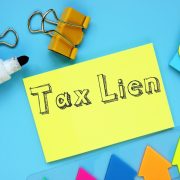Understanding Tax Liens as a Self-Directed IRA Investment
For many retirement investments, it’s easy to see the path forward. Many people like to buy stocks because of the familiarity. Other people like to buy real estate because they understand the scarcity of land. But what about retirement investing with Tax Liens? Well, as a Self-Directed IRA administration firm, we just serve as the custodian on accounts, and we don’t tell you what to invest in. But we can tell you about Tax Liens, and why some investors flock to this unique asset class when using a Self-Directed IRA.
The Tax Lien in a Self-Directed IRA: Understand the Process
The first step to better understanding how Tax Liens work as an asset is to know how they function. A tax lien occurs when a local government has not been able to collect the taxes it was owed on a property, for one reason or another. The government puts a lien on the home. This lien creates a potential asset. For a third-party investor, such as someone using a Self-Directed IRA, the tax lien is something that can be bought. This means the investor can take over the debt. This way, the government gets the taxes it was owed while the investor has an asset to collect money on. Ideally, anyway.
However, if the party who owes the property tax fails to make payment, it’s possible the lien will go into foreclosure. In the event of a foreclosure, an investor can decide whether to sell the property or to hold the property directly, eventually renting it out. In this way, a tax lien can potentially turn into a real estate asset down the road.
Why Do Investors Use Self-Directed IRAs for Tax Liens?
It might seem strange to swoop in on a tax lien and put your money in someone else’s debt, but the asset is more common than it might seem. For starters, any mortgage or car note works the same way: someone else creates a debt, and you create an asset if you’re the lender. Using a Self-Directed IRA doesn’t necessarily change this basic equation; you’re just changing the vehicle for doing so.
So then why do investors use Self-Directed IRAs for arrangements like these? Simple: a Self-Directed IRA affords tax protections on the assets it contains. For instance, the income you generate into a Self-Directed IRA comes in tax-free until it comes time to pay the taxes on the distributions you pull out of it. Or, in the case of a Roth IRA, you may owe no additional taxes on the back-end.
The important thing to note here? Tax Liens are another type of asset, which makes them easy to hold within a retirement account. This means an investor with a funded Self-Directed IRA has the option to invest in the Tax Liens they deem appropriate. As the custodian on the account, a company like American IRA, a Self-Directed IRA administration firm, simply carries out the paperwork and administration. Ultimately, the power of what happens in that Self-Directed IRA lies with you. Combine that with the tax benefits and you begin to see why it’s such a compelling way to invest.
Do you want to learn more about Tax Liens? We’ve compiled a bunch of information for you to review here at the American IRA tax lien website. There you’ll learn about the individual in-state quirks that will change the landscape of Tax Liens, depending on your state’s regulations.
Interested in learning more about Self-Directed IRAs? Contact American IRA, LLC at 866-7500-IRA (472) for a free consultation. Download our free guides or visit us online at www.AmericanIRA.com.









